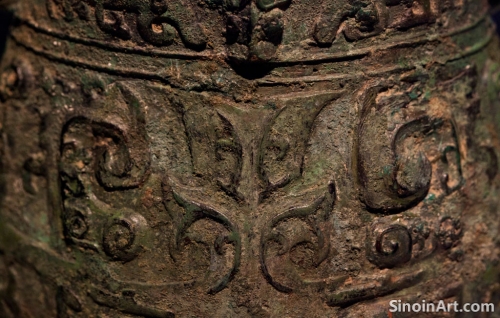The Role of Bronze in Ancient Chinese Funerary Practices: Preparing the Deceased for the Afterlife
|
Bronze objects held a significant place in ancient Chinese funerary practices, reflecting the belief in an afterlife and the need to provide the deceased with the material goods and spiritual protection needed for their journey. The inclusion of bronze items in tombs highlights the importance of ritual in ancient Chinese culture, and it also helps to emphasize the power and prestige of those who were given such burials.  Bronze ritual vessels, often used in ancestral rites and sacrifices, were placed in tombs, suggesting that they were meant to be used in similar ceremonies in the world beyond. These objects served to link the earthly life with the afterlife, and to ensure the wellbeing of the departed in their next life. The inclusion of these objects reflected both status and a desire to protect the spirit of the departed.  Bronze weapons, often included in the tombs of warriors and nobles, were believed to provide protection and power in the afterlife, reflecting a continuation of their earthly roles. The inclusion of bronze weapons in the burials suggests the belief that the same earthly needs would be relevant in the world beyond.  Bronze mirrors, often placed in tombs, were believed to have protective powers and to serve as guides for the deceased as they moved between worlds. The inclusion of these mirrors is a powerful demonstration of a belief in a connection between the worlds of the living and the dead. The study of bronze objects as grave goods provides valuable insights into the funerary customs, beliefs about the afterlife, and the social structures of ancient Chinese society. The careful study of these burials provides a wealth of information about the values and beliefs of the people of the time. |
Tag : bronze funerary practices, ancient Chinese burials, grave goods, afterlife beliefs, tomb artifacts
Related information
- Regional Styles of Bronze Ware: Exploring the Diversity of Ancient China
- The Use of Bronze in Ancient Chinese Maritime Activities: Vessels and Tools
- Bronze Ware and Ancient Chinese Trade: Examining the Role of Material Culture in Economic Exchange
- Bronze Ware and the Development of Ancient Chinese Agriculture: Water Management and Irrigation Systems
- Bronze Ware and Ancient Chinese Conceptions of Time: Cycles, Rituals, and Cosmic Order
This article explores regional styles of bronze ware in ancient China, highlighting the distinct forms, designs, and techniques found in different areas, including the Central Plains, the Yangtze Valley, and the northern regions, revealing the diversity of ancient Chinese culture.
This article explores the use of bronze in ancient Chinese maritime activities, highlighting its role in ship construction, the creation of navigational and fishing tools, and its contribution to the development of trade and exploration.
This article explores the role of bronze ware in ancient Chinese trade, highlighting its use as a valuable commodity, its impact on shaping trade routes and market systems, and its contribution to the broader economic landscape of the time.
This article explores the use of bronze in ancient Chinese agriculture, highlighting its role in creating water management systems, irrigation components, and other implements that were essential for increasing agricultural productivity and supporting a growing population.
This article explores the connection between bronze ware and ancient Chinese conceptions of time, highlighting its role in creating timekeeping devices, marking ritual cycles, and revealing a worldview that emphasized the importance of understanding the cosmos and its patterns.